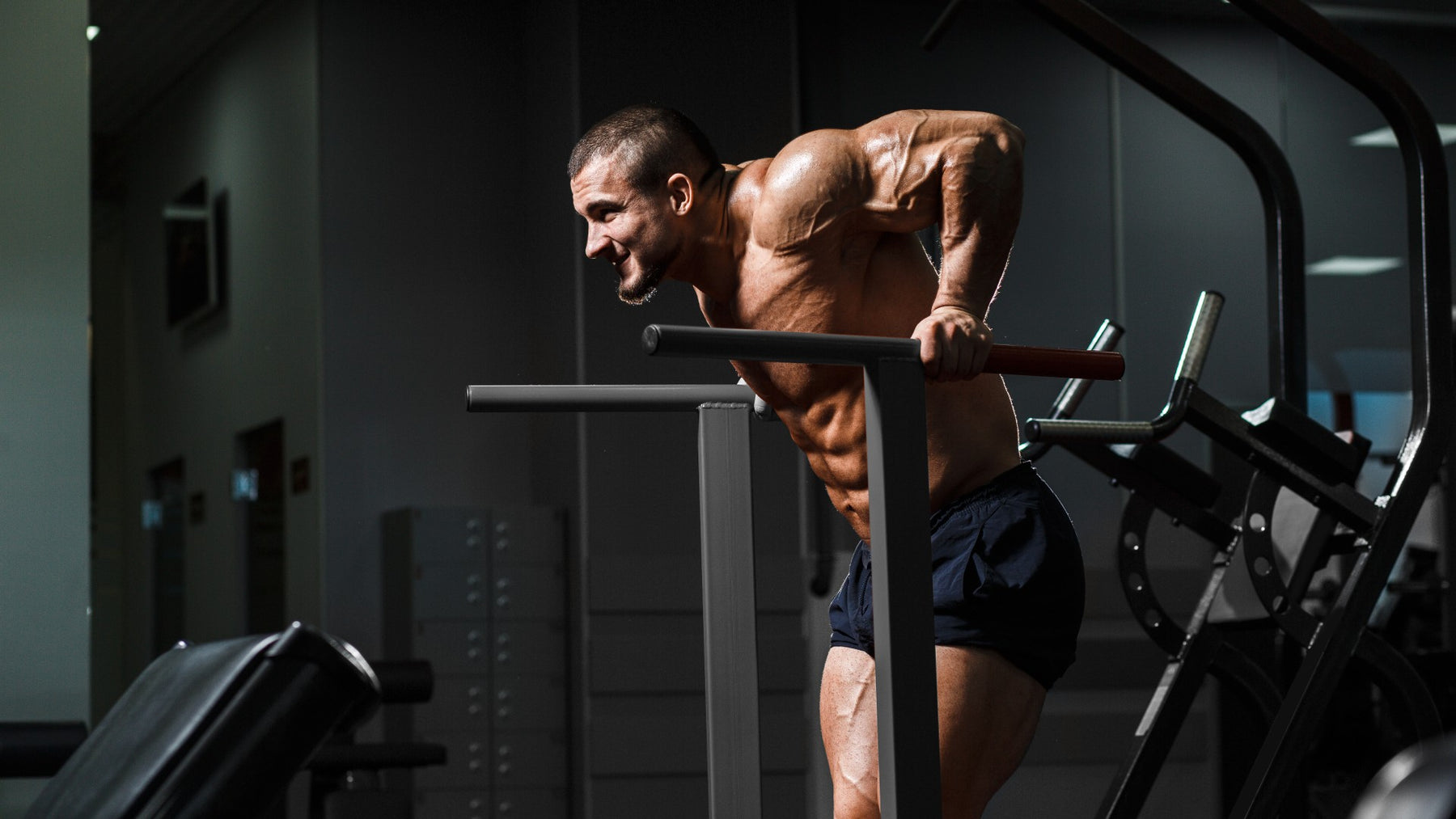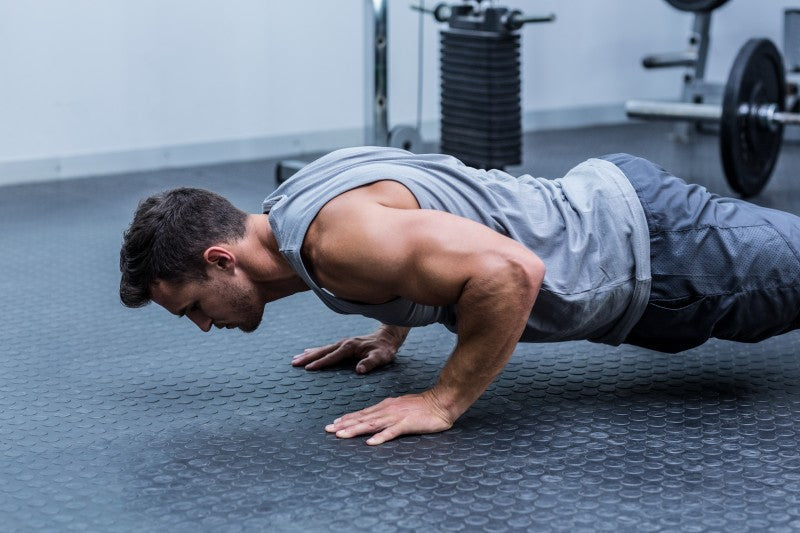
How to Build Muscle Using Limited Equipment
I only have access to 60 pound dumbbells and I have no bench. Can I still build a lot of muscle mass?The answer is yes. Where there is a will, there is a way. In this article I will show you how to make muscle gains using only:
- A set of dumbbells that go up to 60 pounds.
- Bodyweight exercises.
- A $10 pull up bar you can purchase from Wal-mart and hang in your doorway.

All major dumbbell exercises are preceded by a quality bodyweight exercise like push ups, pull ups or jump squats.
Primary Workout Variables
Workouts are comprised of a set of primary variables that can be changed to further challenge the body. These variables are:- Volume. You can add more sets.
- Frequency. You can train more frequently.
- Reps. You can add more reps to sets.
- Time Under Tension. You can slow down reps to increase time under tension.
- Time. You can decrease rest between sets, or utilize no-rest tactics such as supersets, trisets, drop sets etc.
- Resistance. You can increase resistance per set.
Knowing these variables, here is how we are going to attack the muscle building process using a limited amount of equipment.
Maximizing Your Dumbbell Exercises
This section teaches you how to maximize your dumbbell exercises. For most exercises it is unlikely that you will reach step #6. If you do, simply remove the bodyweight exercises that precede that lift (if applicable), and insert them in as supersets between sets of that major exercise (see below).Major dumbbell lifts are preceded by a bodyweight movement. Minor movements are not because you will not reach stage #6 using that exercise. If you do, it's time to buy more plates because you are a beast.
 #1 - Maximize Resistance
#1 - Maximize Resistance
Our main focus will be on maximizing resistance for each exercise. Simply stated, your job is to get stronger. Once you are pushing a given exercise for multiple sets of 12 reps using the 60-pound dumbbells, you will have maximized resistance for that exercise.
Until you get to this strength level, no other tweaks for that exercise are needed.
Note: For a given exercise you will start with 3 sets. When you get to 3 sets x 12 reps with a given weight, add a small amount of resistance to each dumbbell. When you are able to perform 3 sets of 12 reps with your 60-pound dumbbells, move to step #2, which involves adding volume.
You can rest as long as needed between sets but rest periods should be at least 60 seconds and no less. We will reduce rest between sets later.
#2 - Add Volume
Once you reach 3 sets of 12 reps using 60-pound dumbbells, add a 4th set. When you are able to perform 4 sets x 12 reps, add a 5th set. When you are able to perform 5 sets x 12 reps on a given exercise using 60-pound dumbbells, move on to step #3.
#3 - Add Reps
At this point, we are going to focus on increasing reps per set. Don't panic. Despite the noise on the internet, high reps WILL build muscle.
The goal of this step is to reach 5 sets x 20 reps. Remember to keep rest in between sets to a minimum of 60 seconds.
#4 - Add Time Under Tension
If you've reach this stage, an exercise has become extremely challenging and you are starting to pack on muscle mass. The next tweak is to increase time under tension.Up until this point reps were performed with a natural tempo. Now it's time for a change. We are going to move the negative aspect of each rep to a 5 second count.
Once you are able to perform 5 sets x 20 reps using a 5 second count during the eccentric/negative phase of an exercise, it's time for step #5.
Note: 5 second negative counts don't have to be ultra-precise. Simply count out in your head, one-thousand one, one-thousand-two, etc.

Hold each plank as long as possible. Don't worry about where you start. Try to add time each workout.
#5 - Decrease Rest Between Sets
There will be several stages to this step. Once you are able to perform 5 sets x 20 reps using 5 second negatives with the stated rest between sets, lower the rest periods to the next stage.- Stage 1 - Limit rest between sets to exactly 60 seconds
- Stage 2 - Limit rest between sets to exactly 45 seconds
- Stage 3 - Limit rest between sets to exactly 30 seconds
#6 - Superset Using Bodyweight Exercises
It's unlikely that you will reach this stage with most exercises.You will notice that major dumbbell exercises are preceded by a bodyweight movement. Once you reach this stage, it's time to superset. You will remove the bodyweight movement from the start of the workout, and insert them in as supersets. Let's look as an example.
The workout in this article calls for you to start your chest training with 3 sets of push ups for as many reps as possible. Following push ups, you then move on to dumbbell floor presses.
- Push ups - 3 sets x AMAP (as many reps as possible)
- Dumbbell Floor Press - 3 sets x 12 reps
So basically you will perform a set of dumbbell floor presses and immediately do a set of push ups for as many reps as possible. After this first superset, rest exactly 30 seconds and then perform another superset. Continue this pattern until 5 total supersets have been completed.
- Superset #1 - Dumbbell Floor Presses followed by Push Ups for as many reps as possible.
- Rest 30 seconds
- Superset #2 - Dumbbell Floor Presses followed by Push Ups for as many reps as possible.
- Rest 30 seconds
- Superset #3 - Dumbbell Floor Presses followed by Push Ups for as many reps as possible.
- Rest 30 seconds
- Superset #4 - Dumbbell Floor Presses followed by Push Ups for as many reps as possible.
- Rest 30 seconds
- Superset #5 - Dumbbell Floor Presses followed by Push Ups for as many reps as possible.
The Limited Equipment Workout
You will be working out 3 days per week, alternative between 2 different workouts. Here is a sample schedule.Week 1
- Monday - Workout A
- Wednesday - Workout B
- Friday - Workout A
Week 2
- Monday - Workout B
- Wednesday - Workout A
- Friday - Workout B
Remember, sets and reps for dumbbell exercises are merely a starting point. Follow the 6 stage progression system above.
Note: AMAP equals as many reps as possible per set.
| Workout A | |||||
|---|---|---|---|---|---|
| Chest, Shoulders and Arms | |||||
| Exercise | Sets | Reps | |||
| Push Ups | 3 | AMAP | |||
| Dumbbell Floor Bench Press | 3 | 12 | |||
| Pike Push Ups | 3 | AMAP | |||
| Arnold Press | 3 | 12 | |||
| Two Arm Dumbbell Extension | 3 | 12 | |||
| Dumbbell Curl | 3 | 12 | |||
| Workout B | |||||
|---|---|---|---|---|---|
| Legs, Back and Abs | |||||
| Exercise | Sets | Reps | |||
| Bodyweight Jump Squats | 3 | 25 | |||
| Dumbbell Lunges | 3 | 12 | |||
| Pull Ups | 3 | AMAP | |||
| Two Arm Dumbbell Rows | 3 | 12 | |||
| Stiff Leg Dumbbell Deadlifts | 3 | 12 | |||
| Plank | 3 | Max time | |||
Workout Notes
Dumbbell Floor Press. Lie on floor while moving two dumbbells into place near your chest. Begin a bench press-style movement. Obviously, your elbows will be touching the ground at the beginning of each rep. You will still build plenty of chest mass despite the fact that the dumbbells won't be brought to your chest.Pike Push Up. Place your feet on a chair and put your body into an L-shaped position with your arms fully extended and locked. Proceed to lower your head towards the ground and then press yourself back up. Think of this movement as an inverted bodyweight overhead press.
Dumbbell Lunges. If you dislike lunges, try goblet squats instead. It is ok for forsake the slow negatives on lunges if they feel awkward.
Pull Ups. If you can't do pull ups, lower the pull up bar closer to the ground and perform inverted rows. (See below)
Stiff Leg Dumbbell Deadlifts. It is ok to forsake slow negatives if they feel awkward.

 #1 - Maximize Resistance
#1 - Maximize Resistance
Leave a comment